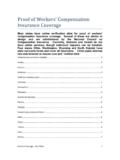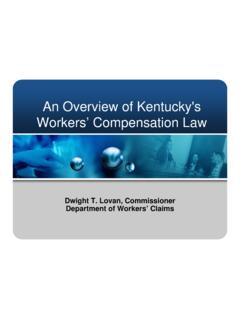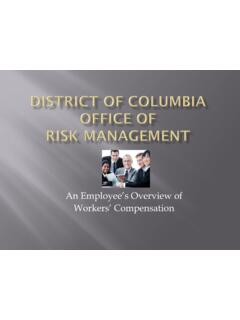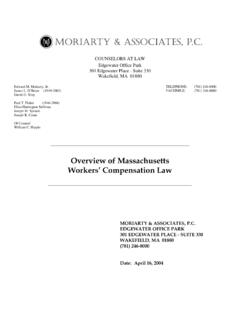Transcription of From John Burton’s Workers’ Compensation Resources …
1 Vol 7 Issue 3 May/June 2007 The article by John Burton provides an Overview of Workers Compensation that ideally will be of value to both neophytes and aficionados in the area. The article provides the historical background for workers Compensation , which helps explain many of the attributes of the program, such as the control by the states. The article also provides a capsule of the legal tests for compensability, including both the historical requirements, such as the requirement for an acci-dent, as well as recent developments, such as the requirement that the current workplace injury be the major contributing cause of the worker s disability.
2 The article also describes the various types of cash and medical benefits provided by workers Compensation programs. The article places particular emphasis of recent developments in workers Compensation insurance arrangements. Since the 1980s, several states have established competitive state workers Compensation funds, while two states have eliminated their exclusive state funds. Meanwhile, the workers compen-sation insurance markets for private carriers have been deregulated in most states. These changes in insurance arrangements produced some expected and some surprising results for the employers costs of workers Compensation insurance.
3 Burton plans to co-author an expanded version of the Overview article later this year. Suggestions from readers would be appreciated about topics not in the article that should be covered, as well as topics that are covered but that should be expanded or shortened. Please send your comments to Summary of the Contents Research and Public Policy for the Workers Disability System From John Burton s Workers Compensation Resources ORKERS OMPENSATION OLICY EVIEW Summary of the Contents 1 An Overview of Workers Compensation .. 3 This issue is being distributed in July 2007.
4 The next issue will follow shortly. In This Issue: FEATURED TOPICS Workers' Compensation Benefits and Employe r s' Co sts a s a Percent of Covered Payroll, 1972 1974 1976 1978 1980 1982 1984 1986 1988 1990 1992 1994 1996 1998 2000 2002 2004 Benefits as a Percent of Covered PayrollCosts as a Percent of Covered Payroll 2 May/June 2007 WORKERS Compensation POLICY REVIEW A Book of Possible Interest to Subscribers Employment Law: Cases and Materials: Fourth Edition has recently been published by Lex-isNexis. The volume, written by Steven L.
5 Willborn, Steward J. Schwab, John F. Burton, Jr., and Gillian L. L. Lester, is widely used in courses in law schools and graduate programs in employment relations, and should be valuable for practicing attorneys and others interested in an overview of em-ployment law. John Burton was the lead author on Part VIII of the book, which contains these head-ings: Part VIII. Workplace Injuries and Diseases Chapter 21. The Prestatutory Approaches A. The Labor Market B. Tort Suits Chapter 22. Workers Compensation A. The Origins of Workers Compensation B. An Overview of Current Workers Compensation Programs C.
6 The Exclusivity of Workers Compensation D. Which Injuries are Compensable? E. Which Diseases are Compensable? F. Injuries and Diseases for Which Compensability is Problematic G. Cash Benefits H. Medical and Rehabilitation Benefits Chapter 23. The Occupational Safety and Health Act A. An Overview of the Act B. Substantive Criteria for OSHA Standards C. Legal Challenges to Permanent Standards D. The General Duty Clause E. Enforcement F. Employee Rights and Responsibilities G. Federal Versus State Authority for Workplace Safety and Health Chapter 24. Rethinking the Approaches to Workplace Injuries and Diseases A.
7 The Labor Market B. Tort Suits C. Workers Compensation D. The Occupational Safety and Health Act Employment Law: Cases and Materials: Fourth Edition. 1167 Pages plus Table of Cases and Index. $ hardcover. ISBN 0-8205-7089-3. Published 2007. Employment Law: Selected Federal and State Statutes. 2007 Edition. 482 Pages. $ pa-perback. ISBN 0-8205-7091-5. Available from LexisNexis, 1275 Broadway, Albany, NY 12204. Phone: 1-800-223-1940. Online: May/June 2007 3 WORKERS Compensation POLICY REVIEW Workers Compensation programs provide cash benefits, medical care, and rehabilitation services to workers who experience work-related Each state has a workers Compensation statute and there are several federal programs.
8 There are some com-mon features of these programs, including the use of several legal tests to determine which injuries are work-related and therefore entitle workers to benefits. There are also significant differences among the jurisdictions, including the weekly amounts and durations of cash benefits. This chapter summarizes the salient similari-ties and differences, with particular emphasis on the insurance arrangements used to provide the benefits. HISTORY Workers Compensation is the oldest social insur-ance program in the , and many of the current fea-tures of the program can only be understood if the con-text in which the program emerged in the first two dec-ades of the 20th century is At that time, a negligence suit (a form of tort or civil remedy) was the only remedy an employee injured at work had against the employer.
9 If the employee won the suit, the recov-ery could be substantial, since the damages could in-clude replacement of lost wages, reimbursement of all medical expenses, and payments for nonpecuniary consequences, such as pain and suffering. An injured worker faced substantial obstacles to winning the suit, however, not only because of the necessity to prove that the employer was negligent, but because the courts had established several legal doctrines that a negligent employer could use to avoid liability. An ex-ample was contributory negligence, which precluded the employee from any recovery if he or she were negli-gent, even if the employer was primarily the negligent party.
10 The conventional view is that few employees were successful in these suits, although occasionally employers were found liable and paid large awards, a combination that neither party liked. The approach was also criticized because recovery depended on the worker bringing a law suit, and the litigation was costly and time consuming. Workers Compensation was designed to overcome some of the deficiencies of the negligence suit ap-proach. All workers Compensation statutes incorporate the workers Compensation principle, which has two elements. Workers Compensation is a no-fault sys-tem, which means that in order to receive benefits, a worker does not need to demonstrate the employer is negligent and the employer cannot use the special de-fenses, such as contributory negligence.










